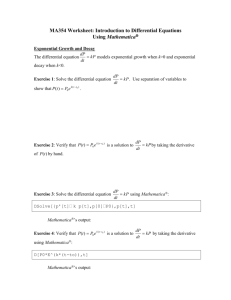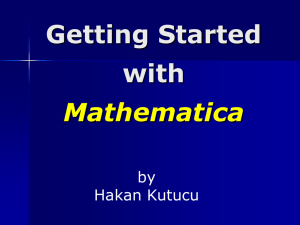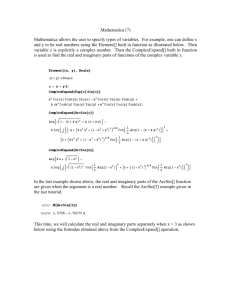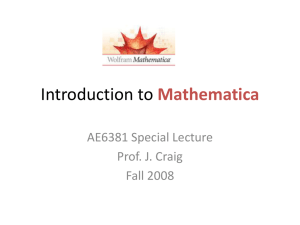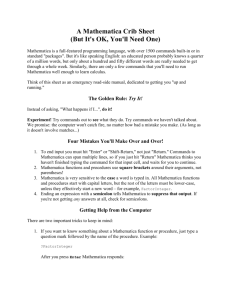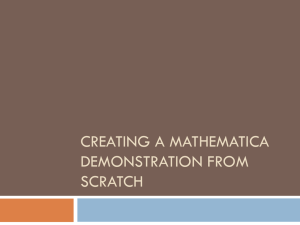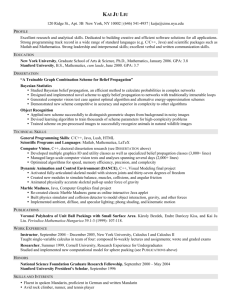Introductory Tutorial to Mathematica 8
advertisement
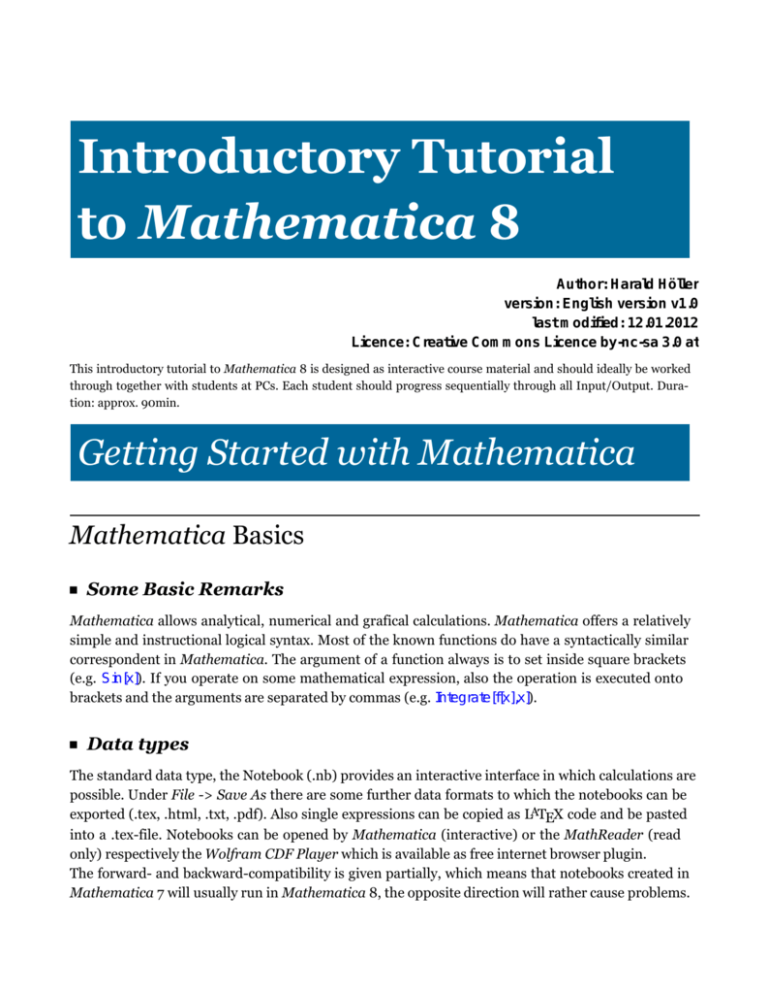
Introductory Tutorial
to Mathematica 8
Author: Harald Höller
version: English version v1.0
last modified: 12.01.2012
Licence: Creative Commons Licence by-nc-sa 3.0 at
This introductory tutorial to Mathematica 8 is designed as interactive course material and should ideally be worked
through together with students at PCs. Each student should progress sequentially through all Input/Output. Duration: approx. 90min.
Getting Started with Mathematica
Mathematica Basics
Some Basic Remarks
Mathematica allows analytical, numerical and grafical calculations. Mathematica offers a relatively
simple and instructional logical syntax. Most of the known functions do have a syntactically similar
correspondent in Mathematica. The argument of a function always is to set inside square brackets
(e.g. Sin[x]). If you operate on some mathematical expression, also the operation is executed onto
brackets and the arguments are separated by commas (e.g. Integrate[f[x],x]).
Data types
The standard data type, the Notebook (.nb) provides an interactive interface in which calculations are
possible. Under File -> Save As there are some further data formats to which the notebooks can be
exported (.tex, .html, .txt, .pdf). Also single expressions can be copied as LATEX code and be pasted
into a .tex-file. Notebooks can be opened by Mathematica (interactive) or the MathReader (read
only) respectively the Wolfram CDF Player which is available as free internet browser plugin.
The forward- and backward-compatibility is given partially, which means that notebooks created in
Mathematica 7 will usually run in Mathematica 8, the opposite direction will rather cause problems.
exported (.tex, .html, .txt, .pdf). Also single expressions can be copied as LATEX code and be pasted
into a .tex-file. Notebooks can be opened by Mathematica (interactive) or the MathReader (read
respectively the Wolfram CDF Player which is available as free internet browser plugin.
2only)
introductory_mathematica_8_tutorial_expand.nb
The forward- and backward-compatibility is given partially, which means that notebooks created in
Mathematica 7 will usually run in Mathematica 8, the opposite direction will rather cause problems.
Wolfram|Alpha
Wolfram|Alpha is a net-based “frontend” for Mathematica usage with a huge database of knowledge.
Describing as “scientific Google” does not really cover its whole power. Either you access it via the
website www.wolframalpha.com or there is even an integration to Mathematica. Beginning an Input
with the “=” sign is interpreted as Wolfram|Alpha query. E.g: “= cosmological redshift z=3”
cosmological redshift z = 3 »
Result
Assuming redshift-wavelength formula È Use cosmological redshift instead
Calculate emitted wavelength È Æ
• observed wavelength:
575 nm
Assuming observed wavelength and emitted wavelength
È Use observed frequency and emitted frequency instead
Also include: dark energy density, matter density and radiation density
È universe model È Hubble parameter
Input information:
redshift-wavelength formula
redshift
3
observed wavelength
575 nm HnanometersL
Result:
More units
emitted wavelength
143.8 nm HnanometersL
5.659 ´ 10-6 inches
0.1438 µm HmicrometersL
Equation:
1+z
Λo
introductory_mathematica_8_tutorial_expand.nb
1+z
3
Λe
Λe
emitted wavelength
z
redshift
Λo
observed wavelength
Cosmological results:
More
time ago Hlookback timeL
11.5 billion years
time since big bang
2.19 billion years
21.1 billion ly Hlight yearsL
6480 Mpc HmegaparsecsL
distance HcomovingL
2 ´ 1023 km HkilometersL
1.24 ´ 1023 miles
fraction of total observable radius
0.453
scale factor
0.25 ´ current value
epoch
matter dominated, post-recombination
radiation temperature
10.9 K HkelvinsL
Hbased on 5-year WMAP data and Lambda-CDM model; current universe age: 13.7
billion yearsL
Timeline:
Big Bang
5 billion years
first galaxies form
emitted wavelength
10 billion years
present
Earth forms
143.8 nm HnanometersL
5.659 ´ 10-6 inches
0.1438 µm HmicrometersL
Input/Output I
The input of commands in Mathematica is done via the Enter key (not Return), which is either
located at the numeric keypad or it can be typed in as Shift + Return. Each Output and Input is numbered by Mathematica.
4
introductory_mathematica_8_tutorial_expand.nb
The input of commands in Mathematica is done via the Enter key (not Return), which is either
located at the numeric keypad or it can be typed in as Shift + Return. Each Output and Input is numbered by Mathematica.
3
3
In this way one can refer to previous In- and Output
In@2D + Out@2D
6
respectively one can refer to the last output via %.
%
6
Help / Documentation Center
Mathematica provides a compresehsive help and documentation center which gets completed by the
online-documentation. By entering the F1 key, the documentation center is opened; one can even
mark an expression in the notebook and will get to the help entry for this term via F1.
For a brief summary of syntax usage and functionality of a function, one can also just enter question
mark + function to get an overwiev.
? Integrate
Integrate@ f , xD gives the indefinite integral à f d x.
Integrate@ f , 8x, xmin , xmax <D gives the definite integral à
xmax
f d x.
xmin
Integrate@ f , 8x, xmin , xmax <, 8y, ymin , ymax <, …D gives the multiple integral à
xmax
xmin
With ?xyz* one gets a list of functions starting with xyz.
d xà
ymax
ymin
dy … f .
introductory_mathematica_8_tutorial_expand.nb
5
? Integ*
System`
Integer
IntegerDigits
IntegerExponent
IntegerPart
IntegerQ
IntegerString
IntegerLength
IntegerPartitions
Integers
Integral
Integrate
The Kernel
Mathematica "remembers" all definitions, In- and Outputs inside a Notebook. As described some
lines before, one can refer to previous terms easily. As long as the Kernel is running, all these definitions are available.
? Random
Random@D gives a uniformly distributed pseudorandom Real in the range 0 to 1.
Random@type, rangeD gives a pseudorandom number of the specified type, lying in the
specified range. Possible types are: Integer, Real and Complex. The default range is 0 to 1. You
can give the range 8min, max< explicitly; a range specification of max is equivalent to 80, max<.
a = Random@Integer, 100D
b = Random@Integer, 100D
c = Random@Integer, 100D
22
53
3
a+b+c
78
If you want to delete entires in this memory of definitions, the Clear[Arguments] command can be
used. If you want to clear all kernel memory, i.e. kill and restart the kernel, then go to Evaluation ->
Quit Kernel -> Local. This also terminates running calculations which comes in handy, when you
realize that a calculation seems to have got stuck and you don’t want to wait any longer.
6
introductory_mathematica_8_tutorial_expand.nb
? Clear
Clear@symbol1 , symbol2 , …D clears values and definitions for the symboli .
Clear@" form1 ", " form2 ", …D clears values and
definitions for all symbols whose names match any of the string patterns formi .
Clear@a, b, cD
a+b+c
a+b+c
If one wishes not to quit ther kernel but delete all previous definitions, (of all currently opened Mathematica-Notebooks) the syntax is as follows.
Clear@"Global`*"D
Comments
Comments (i.e. non to be executed, read-only text parts) inside Input-lines can by typed inside round
brackets and stars.
Sqrt@2D
H* Square root of 2 can also be typed via "Ctrl + 2": *L
2
True
Shortcuts
There is a number of shortcuts and hotkeys in order to simplify typing formulas to the notebook.
Some examples:
ai H* Subscript via "Ctrl + -" *L;
1
H* Fraction lines via "Ctrl + " *L;
2
à H*"Esc + int + Esc" *Lf@xD âx H* "Esc + dd + Esc" *L;
¥ H* "Esc + inf + Esc" *L;
Α H* Also greek letters via "Esc + Letter + Esc" *L;
introductory_mathematica_8_tutorial_expand.nb
7
Syntax Highlighting
When typing formulae in a Mathematica notebook, syntax highlighting is very convenient. Known
Functions, trailing brackets, arguments etc. are recognoized and highlighted; either as positive feedback that everything is alright or - usually even more helpful - as negative feedback that there is some
syntactic problem. In case the syntax is faulty, klick on the plus-sign on the right hand side of the
input line to get more information about what might be wrong.
SolveASinAx_ + 3 + CosAx_E = 1, yE
Symbolic Calculus in Mathematica - Basics
Input/Output II
The decimal separator is the dot (.) verwendet, not the comma. A space character is interpreted as
scalar multiplicator (“times”) and replaced by a cross.
3.14 ´ 3.14
9.8596
Definitions and Assignments
The simplest form of assigning a right hand side to a left hand side was already presented, namely the
equal sign.
?=
lhs = rhs evaluates rhs and assigns the result
to be the value of lhs. From then on, lhs is replaced by rhs whenever it appears.
8l1 , l2 , …< = 8r1 , r2 , …< evaluates the ri , and assigns the results to be the values of the corresponding li .
d=1
1
One can surpress the otput of an assignment by adding a colon. This assigment is evaluated not until
the definition is being used somewhere later in the Notebook. This assignment is especially useful
when the right hand side is somewhat elongate and evaluation costs computation time.
8
introductory_mathematica_8_tutorial_expand.nb
? :=
lhs := rhs assigns rhs to be the delayed value of lhs. rhs is maintained in
an unevaluated form. When lhs appears, it is replaced by rhs, evaluated afresh each time.
f := 1
Functions + Pattern
One main powerfulness of CAS such as Mathematica is symbolic calculus, i.e. working with functions. There is one little syntax peculiarity of Mathematica concerning this topic. Objects with arguments in the form f[x] are static; if you want the argument to be variable, then definition of the function must add an underscore (see Mathematica documentation center under keyword Pattern) to
each argument that should be a variable.
DONT :
h@xD := Sin@xD
h@1D
h@1D
DO :
gAx_E := Sin@xD
g@1D
Sin@1D
As you can see, Mathematica does not necessarily output numerical values. In this case, the result is
an irrational number and one needs to specify further if and what numerical outoput is wanted.
Input/Output III
In order to force numerical output, one needs to type N[Argument,Digits].
introductory_mathematica_8_tutorial_expand.nb
9
N@g@1D, 100D
0.8414709848078965066525023216302989996225630607983710656727517099
919104043912396689486397435430526959
There is also the possibility to append functions and objetcs that operate on the whole expression by
a double slash.
g@1D N
0.841471
Basic Calculus (Scalars)
An addition of objetcs (scalars as well as vectors and matrices) is typed - as expected - via the plus (+)
key, subtraction via minus (-). Scalar multiplication can be set via the star (*) or a blank character,
division is typed viaone slash.
2*2
4
2´2
4
22
1
Nested expressions are typed as “with pen and paper” using round brackets.
H1 + H4 - 3L * 2L H1 + 1L + 1
5
2
10
introductory_mathematica_8_tutorial_expand.nb
Clear@"Global`*"D
H* please enter this input to delete all previous definitions
which would partially conflict with the upcoming section *L
Basic Commands - I/O III
Until now we have seen Mathematica mainly as somewhat sophisticated calculator. However its true
power abounds when applying such a computer algebra system to complex problems such as integrals, differential equations or algebraic system of equations that are hardly or even not solvable at
all with pen and paper.
E.g.: Differentiation
Just to get used to the syntax we regard a simple example. The differentiation symbol is the capital D:
?D
D@ f , xD gives the partial derivative ¶ f ¶ x.
D@ f , 8x, n<D gives the multiple derivative ¶n f ¶ xn .
D@ f , x, y, …D differentiates f successively with respect to x, y, ….
D@ f , 88x1 , x2 , …<<D for a scalar f gives the vector derivative H¶ f ¶ x1 , ¶ f ¶ x2 , …L.
D@ f , 8array<D gives a tensor derivative.
When we compute the first derivative of a general function F[x], we get the output F'[x]. As described
in the Mathematica documentation, the arguments (function and variable) of this operation are
separated by a comma.
D@F@xD, xD
F¢ @xD
We have to further specify the function to be derived in order to get a calculated output of course. As
an example we define a function G in and compute ther first partial derivative with respecto to one
variable,
GAx_, y_E := x * y
D@G@x, yD, yD
x
introductory_mathematica_8_tutorial_expand.nb
the second partial derivative
D@G@x, yD, 8x, 2<D
0
or subsequent derivatives with respect to a list of variables.
D@G@x, yD, x, yD
1
Simplify und Expand
? Simplify
Simplify@exprD performs a sequence of algebraic and other transformations on expr, and returns the simplest form it finds.
Simplify@expr, assumD does simplification using assumptions.
? FullSimplify
FullSimplify@exprD tries a wide range of transformations on
expr involving elementary and special functions, and returns the simplest form it finds.
FullSimplify@expr, assumD does simplification using assumptions.
? Expand
Expand@exprD expands out products and positive integer powers in expr.
Expand@expr, pattD leaves unexpanded any parts of expr that are free of the pattern patt.
E.g.: Polynom
x * Hx + 1L^3 + Hx^2 - 3 * xL^5 + x + 1 + x^2 + Hx - x^2 + Hx - 1L^2L^2
1 + x + x2 + x H1 + xL3 + IH-1 + xL2 + x - x2 M + I-3 x + x2 M
2
5
11
12
introductory_mathematica_8_tutorial_expand.nb
FullSimplify@%D
2 + x2 I5 + x I3 + x I1 + H-3 + xL5 xMMM
Expand@%D
2 + 5 x2 + 3 x3 + x4 - 243 x5 + 405 x6 - 270 x7 + 90 x8 - 15 x9 + x10
Plots / Graphics / Figures - Basics
Plot
A major scientific tool in Mathematica is the manifold of plotting routines that help you to depict
mathematical results grafically. The basic syntax for 2D graphs (as they are of course also done by
muich simpler programs like gnuplot) is Plot[Argument, {Variables, Boundaries}]. These boundaries
define the abscissa, the ordinate is scaled with the additional argument, namely PlotRange ->
{Boundaries}.
? Plot*
System`
Plot
Plot3Matrix
PlotJoined
PlotLayout
PlotPoints
PlotRangeClipping
Plot3D
PlotDivision
PlotLabel
PlotMarkers
PlotRange
PlotRangePadding
PlotRegion
PlotStyle
introductory_mathematica_8_tutorial_expand.nb
Plot Functions
Plot@Exp@xD, 8x, 0, 10<D
8000
6000
4000
2000
2
4
6
8
10
Plot@Sin@xD x, 8x, -10, 10<D
1.0
0.8
0.6
0.4
0.2
-10
-5
5
-0.2
10
13
14
introductory_mathematica_8_tutorial_expand.nb
Plot@1 x^2, 8x, -10, 10<, PlotRange ® 80, 5<,
PlotStyle -> 8Thick, Dashed<, Background ® White, Filling ® AutomaticD
5
4
3
2
1
-10
-5
0
5
10
Dynamic Graphics
The two major commands for interactice plotting are:
? Dynamic
Dynamic@exprD represents an object that displays as the dynamically updated current value
of expr. If the displayed form of Dynamic@exprD is interactively changed or edited, an assignment
expr = val is done to give expr the new value val that corresponds to the displayed form.
Dynamic@expr, NoneD does not allow interactive changing or editing.
Dynamic@expr, f D continually evaluates f @val, exprD during interactive changing or editing of val.
Dynamic@expr, 8 f , fend <D also evaluates fend @val, exprD when interactive changing or editing is complete.
Dynamic@expr, 8 fstart , f , fend <D also evaluates fstart @val, exprD when interactive changing or editing begins.
? Manipulate
Manipulate@expr, 8u, umin , umax <D generates a version
of expr with controls added to allow interactive manipulation of the value of u.
Manipulate@expr, 8u, umin , umax , du<D allows the value of u to vary between umin and umax in steps du.
Manipulate@expr, 88u, uinit <, umin , umax , …<D takes the initial value of u to be uinit .
Manipulate@expr, 88u, uinit , ulbl <, …<D labels the controls for u with ulbl .
Manipulate@expr, 8u, 8u1 , u2 , …<<D allows u to take on discrete values u1 , u2 , ….
Manipulate@expr, 8u, …<, 8v, …<, …D provides controls to manipulate each of the u, v, ….
Manipulate@expr, cu -> 8u, …<, cv -> 8v, …<, …D
links the controls to the specified controllers on an external device.
introductory_mathematica_8_tutorial_expand.nb
Manipulate@Plot@a * Sin@a * xD x,
8x, -7, 7<, PlotRange ® 8-15, 15<D, 8a, 0, 10, 1<D
a
15
10
5
-6
-4
-2
2
4
-5
-10
-15
Graphics und Show
? Graphics
Graphics@ primitives, optionsD represents a two-dimensional graphical image.
? Show
Show@graphics, optionsD shows graphics with the specified options added.
Show@g1 , g2 , …D shows several graphics combined.
6
15
16
introductory_mathematica_8_tutorial_expand.nb
Show@Plot@Sin@xD, 8x, 0, Pi<,
AspectRatio ® Automatic, PlotStyle ® 8Thick, Gray<,
Background ® White, PlotRange ® 80, 2.5<D,
Plot@Exp@-xD - x + x^2, 8x, 0, Pi<, AspectRatio ® Automatic,
PlotStyle ® 8Thick, Blue<,
Background ® White, PlotRange ® 80, 2.5<D,
Graphics@8Thick, Gray, Arrow@880.2, Sin@0.2D<, 80.2, 2<<D<D,
Graphics@8Thick, Gray, Arrow@88.5, Sin@.5D<, 8.5, 2<<D<D,
Graphics@8Thick, Gray, Arrow@88.8, Sin@.8D<, 8.8, 2<<D<D,
Graphics@8Thick, Gray, Arrow@881.1, Sin@1.1D<, 81.1, 2<<D<D,
Graphics@8Thick, Gray, Arrow@881.1, Sin@1.1D<, 81.1, 2<<D<D,
Graphics@8Thick, Blue, Arrow@881.7, Exp@-1.7D - 1.7 + 1.7^2<,
82.5, Exp@-1.7D - 1.7 + 1.7^2<<D<D,
Graphics@8Thick, Blue, Arrow@881.8, Exp@-1.8D - 1.8 + 1.8^2<,
82.5, Exp@-1.8D - 1.8 + 1.8^2<<D<D,
Graphics@8Thick, Blue, Arrow@881.9, Exp@-1.9D - 1.9 + 1.9^2<,
82.5, Exp@-1.9D - 1.9 + 1.9^2<<D<D,
Graphics@8Thick, Blue, Arrow@882, Exp@-2D - 2 + 2^2<,
82.5, Exp@-2D - 2 + 2^2<<D<D,
Graphics@8Thick, Red, Circle@82, 1<D<D,
Graphics@8Thick, Red, Circle@82, 1<, 1.1, 8-Pi 8, 0<D<D,
Graphics@8Thick, Red, Circle@82, 1<, 1.1, 8Pi 8, 2 * Pi 8<D<D,
Graphics@8Thick, Red, Circle@82, 1<, 1.1, 83 * Pi 8, 4 * Pi 8<D<D,
Graphics@8Thick, Red, Circle@82, 1<, 1.1, 85 * Pi 8, 6 * Pi 8<D<D,
Graphics@8Thick, Red, Circle@82, 1<, .9, 8-Pi 8, 0<D<D,
Graphics@8Thick, Red, Circle@82, 1<, .9, 8Pi 8, 2 * Pi 8<D<D,
Graphics@8Thick, Red, Circle@82, 1<, .9, 83 * Pi 8, 4 * Pi 8<D<D,
Graphics@8Thick, Red, Circle@82, 1<, .9, 85 * Pi 8, 6 * Pi 8<D<D
D
introductory_mathematica_8_tutorial_expand.nb
17
2.5
2.0
1.5
1.0
0.5
0.0
0.5
1.0
1.5
2.0
2.5
3.0
Linear Algebra - Calculus on Lists,
Vectors, Matrices etc.
On The Difference Between Lists and Vectors
Handling Vectors, Matrices and Tensors
Whenever working with CAS respectively even more basic level of data processing such as using
common programming languages, one has to keep in mind that a list of entries does not necessarily
make a vector, nor does a two dimensional list make a tensor etc. From algebra we know that all
tensorial quantities are only defined properly when also defining a base. This standard base is - as
expected - the cartesian n-dimensional unit base if nothing else is specified.
A list of functions, numbers or otherwise entries is input via curly brackets and the comma as separator.
vec = 8a, b, c, d<
8a, b, c, d<
18
introductory_mathematica_8_tutorial_expand.nb
? Dimensions
Dimensions@exprD gives a list of the dimensions of expr.
Dimensions@expr, nD gives a list of the dimensions of expr down to level n.
Dimensions@vecD
84<
Of course this concept can be used to arbitrarily interlace lists of lists etc.
tensor := 888a, b, c<, 8a, b, c<, 8a, b, c<, 8a, b, c<<,
88a, b, c<, 8a, b, c<, 8a, b, c<, 8a, b, c<<<
Dimensions@tensorD
82, 4, 3<
E.g.: The Identity Matrix
? IdentityMatrix
IdentityMatrix@nD gives the n ´ n identity matrix.
M := IdentityMatrix@10D
Dimensions@MD
810, 10<
introductory_mathematica_8_tutorial_expand.nb
E.g.: Automatic Filling of Lists
? Table
Table@expr,
Table@expr,
Table@expr,
Table@expr,
Table@expr,
8imax <D generates a list of imax copies of expr.
8i, imax <D generates a list of the values of expr when i runs from 1 to imax .
8i, imin , imax <D starts with i = imin .
8i, imin , imax , di<D uses steps di.
8i, 8i1 , i2 , …<<D uses the successive values i1 , i2 , ….
Table@expr, 8i, imin , imax <, 8 j, jmin , jmax <, …D gives a nested list. The list associated with i is outermost.
H = Table@1 Hi + j - 1L, 8i, 1, 15<, 8j, 1, 15<D;
% MatrixForm
1
1
2
1
3
1
4
1
5
1
6
1
7
1
8
1
9
1
10
1
11
1
12
1
13
1
14
1
15
1
2
1
3
1
4
1
5
1
6
1
7
1
8
1
9
1
10
1
11
1
12
1
13
1
14
1
15
1
16
1
3
1
4
1
5
1
6
1
7
1
8
1
9
1
10
1
11
1
12
1
13
1
14
1
15
1
16
1
17
1
4
1
5
1
6
1
7
1
8
1
9
1
10
1
11
1
12
1
13
1
14
1
15
1
16
1
17
1
18
1
5
1
6
1
7
1
8
1
9
1
10
1
11
1
12
1
13
1
14
1
15
1
16
1
17
1
18
1
19
1
6
1
7
1
8
1
9
1
10
1
11
1
12
1
13
1
14
1
15
1
16
1
17
1
18
1
19
1
20
1
7
1
8
1
9
1
10
1
11
1
12
1
13
1
14
1
15
1
16
1
17
1
18
1
19
1
20
1
21
? Subscript
Subscript@x, yD is an object that formats as x y .
Subscript@x, y1 , y2 , …D formats as x y1 ,y2 ,… .
1
8
1
9
1
10
1
11
1
12
1
13
1
14
1
15
1
16
1
17
1
18
1
19
1
20
1
21
1
22
1
9
1
10
1
11
1
12
1
13
1
14
1
15
1
16
1
17
1
18
1
19
1
20
1
21
1
22
1
23
1
10
1
11
1
12
1
13
1
14
1
15
1
16
1
17
1
18
1
19
1
20
1
21
1
22
1
23
1
24
1
11
1
12
1
13
1
14
1
15
1
16
1
17
1
18
1
19
1
20
1
21
1
22
1
23
1
24
1
25
1
12
1
13
1
14
1
15
1
16
1
17
1
18
1
19
1
20
1
21
1
22
1
23
1
24
1
25
1
26
1
13
1
14
1
15
1
16
1
17
1
18
1
19
1
20
1
21
1
22
1
23
1
24
1
25
1
26
1
27
1
14
1
15
1
16
1
17
1
18
1
19
1
20
1
21
1
22
1
23
1
24
1
25
1
26
1
27
1
28
1
15
1
16
1
17
1
18
1
19
1
20
1
21
1
22
1
23
1
24
1
25
1
26
1
27
1
28
1
29
19
20
introductory_mathematica_8_tutorial_expand.nb
Table@Subscript@m, i, jD, 8i, 3<, 8j, 3<D MatrixForm
m1,1 m1,2 m1,3
m2,1 m2,2 m2,3
m3,1 m3,2 m3,3
Coordinate Systems + Vector Calculus
Since the topic of coordinate systems is especially interesting in physical and astrophysical applications, we want to take a look at the implemented functionalities in Mathematica. A number of packages in Mathematica are not loaded into the Kernel by default (which makes the startup faster) but
have to be loaded on demand. The VectorAnalysis package is one of those - other exaples can be
found here: tutorial/PackagesForSymbolicMathematics.
The VectorAnalysis Package
Loading the package
Needs@"VectorAnalysis`"D
enables a number of additional commands. E.g. with
CoordinateSystem
Cartesian
one can inquire the momentarily used coordinate system. As mentioned before, this is cartesian by
default. When we change to a spherical coordinate system (remark: “American” coordinate ranges by
default)
SetCoordinates@Spherical@r, Θ, ΦDD
Spherical@r, Θ, ΦD
and compute the divergence of the unit vector in r-direction, (1,0,0), we get the well known result.
Div@81, 0, 0<D
2
r
introductory_mathematica_8_tutorial_expand.nb
21
JacobianMatrix@SphericalD MatrixForm
Cos@ΦD Sin@ΘD r Cos@ΘD Cos@ΦD -r Sin@ΘD Sin@ΦD
Sin@ΘD Sin@ΦD r Cos@ΘD Sin@ΦD r Cos@ΦD Sin@ΘD
Cos@ΘD
-r Sin@ΘD
0
Just as further example for some functionalities of that package, we calculate the unit volume of a
cylindre with radius and height one by the differential geometric rule as the integral over the Jacobian determinant.
SetCoordinates@Cylindrical@r, Θ, zDD
Cylindrical@r, Θ, zD
Integrate@JacobianDeterminant@CylindricalD,
8r, 0, 1<, 8Θ, 0, 2 * Π<, 8z, 0, 1<D
Π
Just to check, we compute the divergence of the unit vector in x-direction for cartesian coordinates
SetCoordinates@CartesianD
Cartesian@Xx, Yy, ZzD
Div@81, 0, 0<D
0
which vanishes of course.
Scalar Product, Cross Product
Even without the VectorAnalysis package activated, there are vector commands loaded by default,
such as the scalar (inner) product of two vectors, input via the dot (.).
vec = 8a, b, c<
8a, b, c<
22
introductory_mathematica_8_tutorial_expand.nb
vec.vec
a2 + b2 + c2
With the star * the entries of the list are multiplied pairwise.
vec * vec
9a2 , b2 , c2 =
The cross profuct (vector product) is set with the command Cross.
Cross@vec, vecD
80, 0, 0<
Since a vector is parallel to itself, the cross product has to vanish.
Cross@81, 0, 0<, 80, 1, 0<D
80, 0, 1<
The cross product between two unit base vectors in three dimensions yields the third unit base vector.
Solving Sets of Equations
optional: Solving Linear Sets of Equations
One of the most importand application of computer algebra and numerical codes is solving systems
of equations. Wether you want to solve a complicated switching circuit by solving the Kirchhoff rules
or you look for the numerical solution of differential equations, mathematically these problems
reduce to solving (huge) sets of linear equations or - even more basic - it means to invert big matrices.
Although CAS and numerical schemes are very powerful tools for computationally expensive problems, there are of course limitations as well. This shall be demonstrated with the help of a little example.
The main command for solving linear systems of equations is
introductory_mathematica_8_tutorial_expand.nb
23
? LinearSolve
LinearSolve@m, bD finds an x which solves the matrix equation m.x == b.
LinearSolve@mD generates a LinearSolveFunction@…D which can be applied repeatedly to different b.
which solves equations of the form m.x=b.
E.g.: Hilbert - Matrix
We ragard an arbitrary real vector b (filled with random real numbers between 0 and 100)
b = Table@Random@Integer, 100D, 8n, 1, 15<D
831, 84, 7, 64, 98, 93, 11, 84, 30, 94, 51, 62, 75, 11, 9<
and solve the system H.x=b, i.e. we want to determine the solution vector x. The matrix H was
defined above in subsection “Automatic Filling of Lists “.
LinearSolve@H, bD MatrixForm
-3 734 071 933 185
751 754 904 677 280
-37 714 435 829 386 680
828 864 504 280 612 800
-9 984 977 804 685 904 020
74 111 982 969 427 603 200
-362 869 877 239 232 683 320
1 221 043 396 114 981 604 880
-2 889 102 402 497 160 559 710
4 847 877 238 595 981 990 400
-5 737 637 243 526 263 875 800
4 682 450 439 923 249 994 000
-2 507 202 365 724 910 608 300
792 653 569 836 038 568 000
-112 131 660 922 158 101 400
On some computers this may take quite some time since the determinant of this matrix, also known
as Hilbert-Matrix, gets numerically very small with increasing problem size. From the theory of
linear algebra we know that a system of linear equations is only solvable when the determinant is
non-zero. Computationally, matrix inversion gets more and more expensive, the smaller the determinant.
24
introductory_mathematica_8_tutorial_expand.nb
? Det
Det@mD gives the determinant of the square matrix m.
Det@HD N
1.05854 ´ 10-124
The determinant of the 15-dim. Hilbert-Matrix is “practically” zero. The higher dimensional H, the
smaller gets its determinant and the more difficult gets its inversion.
? HilbertMatrix
HilbertMatrix@nD gives the n´n Hilbert matrix with elements of the form 1 Hi + j - 1L.
HilbertMatrix@8m, n<D gives the m´n Hilbert matrix.
Det@HilbertMatrix@50DD N
1.392615568935140 ´ 10-1466
Clear@"Global`*"D
Solving Coupled Systems of Equations
Clearly we are often also confronted with nonlinear sets of coupled equations, where we cannot
express the problem as sketched before. In this case, we apply the command
? Solve
Solve@expr, varsD attempts to solve the system expr of equations or inequalities for the variables vars.
Solve@expr, vars, domD solves over the domain dom. Common choices of dom are Reals, Integers, and Complexes.
in which documentation entry it states already indicatively that it “attempts to solve” the problem
posed. Mathematica has implemented a variety of algorithms that are tried out.
introductory_mathematica_8_tutorial_expand.nb
E.g. : System of three linear equations
Solve@83 * a b, 2 * a c, c 1<, 8a, b, c<D
::a ®
1
2
, b®
3
2
, c ® 1>>
25
26
introductory_mathematica_8_tutorial_expand.nb
E.g.: System of three nonlinear equations
Solve@83 * a^3 b^2, 2 * a^2 c^2, c^3 1<, 8a, b, c<D
::a ® -
1
, b®-
ä
2
:a ®
1
, b®-
2
:a ® -
-
:a ® -
-
1
-
1
-
:a ®
-
1
-
-
ä
ä
-
:a ® -
-
-
ä
:a ®
-
1
4
, b®
, b®-
, b®
4
1
+
ä
1
+
+
3
ä
3
ä
3
4
2
, b®
2
1
3
2
2
2
2
, b®-
1
J-1 - ä
J-1 - ä
3
ä
, b®
1
2
3
ä
2
, b®-
, b®
2
1
3
2
2
1
3
2
2
3
234
J-1 - ä
J-1 - ä
3
ä
2
3
1
3
ä
3
4
ä
1
1
4
+
1
4
4
1
, b®-
2
3
4
-
3
, b®
2
2
3
4
:a ®
, c ® 1>, :a ®
4
4
:a ® -
3
1
ä
34
34
3N
34
J-1 + ä
J-1 + ä
J-1 + ä
, c®
, c®
, c®
1
2
34
34
3N
34
34
1
2
3N
1
2
3N
3N
, c®
1
2
3N
34
, c ® 1>,
, c ® 1>,
3N
3N
J-1 + ä
3
234
2
4
4
1
234
, c ® 1>, :a ® -
4
4
:a ®
234
3
ä
4
3
J-1 + ä
J-1 + ä
J-1 + ä
, c®
1
2
, c®
1
2
, c®
1
2
, c®
1
2
J-1 + ä
3 N>,
3 N>,
3 N>,
J-1 - ä
J-1 - ä
J-1 - ä
J-1 - ä
3 N>,
3 N>,
3 N>,
3 N>,
3 N>>
Mathematica will list all found solutions also if they sometimes not usable for our purposes because
they are unphysical or violate some other conditions. In this case we frequently have to come back to
pen and paper in order to pick the “right” results.
introductory_mathematica_8_tutorial_expand.nb
27
Mathematica will list all found solutions also if they sometimes not usable for our purposes because
they are unphysical or violate some other conditions. In this case we frequently have to come back to
pen and paper in order to pick the “right” results.
Some more useful commands concerning linear algebra:
? RandomReal
RandomReal@D gives a pseudorandom real number in the range 0 to 1.
RandomReal@8xmin , xmax <D gives a pseudorandom real number in the range xmin to xmax .
RandomReal@xmax D gives a pseudorandom real number in the range 0 to xmax .
RandomReal@range, nD gives a list of n pseudorandom reals.
RandomReal@range, 8n1 , n2 , …<D gives an n1 n2 … array of pseudorandom reals.
A = RandomReal@8-1, 1<, 85, 5<D
88-0.474727, 0.388645, -0.461371, 0.938493, 0.950533<,
80.830478, 0.139342, -0.801181, 0.0834233, 0.259048<,
80.606089, 0.750426, -0.0652498, 0.50112, -0.928461<,
8-0.903335, 0.207855, 0.368359, -0.051829, 0.0604615<,
80.0480989, -0.359201, 0.128467, 0.236191, -0.0770996<<
? MatrixRank
MatrixRank@mD gives the rank of the matrix m.
MatrixRank@AD
5
? Eigenvalues
Eigenvalues@mD gives a list of the eigenvalues of the square matrix m.
Eigenvalues@8m, a<D gives the generalized eigenvalues of m with respect to a.
Eigenvalues@m, kD gives the first k eigenvalues of m.
Eigenvalues@8m, a<, kD gives the first k generalized eigenvalues.
Eigenvalues@AD
80.195529 + 1.07151 ä, 0.195529 - 1.07151 ä,
-0.325532 + 0.509743 ä, -0.325532 - 0.509743 ä, -0.269558<
28
introductory_mathematica_8_tutorial_expand.nb
? Eigenvectors
Eigenvectors@mD gives a list of the eigenvectors of the square matrix m.
Eigenvectors@8m, a<D gives the generalized eigenvectors of m with respect to a.
Eigenvectors@m, kD gives the first k eigenvectors of m.
Eigenvectors@8m, a<, kD gives the first k generalized eigenvectors.
Eigenvectors@AD
880.144597 + 0.32199 ä, 0.647119 + 0. ä, 0.0223833 - 0.456948 ä,
-0.391941 - 0.0945935 ä, -0.127755 + 0.261649 ä<,
80.144597 - 0.32199 ä, 0.647119 + 0. ä, 0.0223833 + 0.456948 ä,
-0.391941 + 0.0945935 ä, -0.127755 - 0.261649 ä<,
8-0.0352433 - 0.480426 ä, -0.327103 - 0.0011468 ä,
-0.259849 - 0.380617 ä, 0.542821 + 0. ä, -0.276221 - 0.278583 ä<,
8-0.0352433 + 0.480426 ä, -0.327103 + 0.0011468 ä,
-0.259849 + 0.380617 ä, 0.542821 + 0. ä, -0.276221 + 0.278583 ä<,
80.320862, 0.369529, 0.656308, -0.272299, 0.505578<<
? CharacteristicPolynomial
CharacteristicPolynomial@m, xD gives the characteristic polynomial for the matrix m.
CharacteristicPolynomial@8m, a<, xD gives the generalized characteristic polynomial with respect to a.
CPAx_E = CharacteristicPolynomial@A, xD
-0.116983 - 0.603626 x - 0.979111 x2 - 1.36765 x3 - 0.529564 x4 - x5
The eigenvalues of a matrix (resp. a linear map) are the zeros of the characteristical polynomial
which we can probe:
CP@Eigenvalues@ADD
92.22045 ´ 10-16 + 0. ä, 2.22045 ´ 10-16 + 0. ä,
-2.77556 ´ 10-17 + 5.55112 ´ 10-17 ä,
-2.77556 ´ 10-17 - 5.55112 ´ 10-17 ä, -1.73472 ´ 10-17 =
... is approximately zweo.
Analysis - Working with Functions,
Derivatives, Integrals
introductory_mathematica_8_tutorial_expand.nb
29
Analysis - Working with Functions,
Derivatives, Integrals
Introductory Remarks
Mathematical Entities in Mathematica
As mentioned before, Mathematica has some syntactic idiosyncrasies. As an example we regard one
of the most beautiful formulas in mathematics:
DONT :
e^Hi * piL -1
ei pi -1
DO :
E^HI * PiL -1
True
?E
E is the exponential constant e Hbase of natural logarithmsL, with numerical value > 2.71828.
?I
I represents the imaginary unit
-1 .
? Pi
Pi is Π, with numerical value > 3.14159.
30
introductory_mathematica_8_tutorial_expand.nb
? Infinity
Infinity or ¥ is a symbol that represents a positive infinite quantity.
optional: Natural Constants etc.
<< PhysicalConstants`
SpeedOfLight
299 792 458 Meter
Second
FineStructureConstant
0.00729735
AgeOfUniverse
4.7 ´ 1017 Second
MagneticFluxQuantum
2.06783 ´ 10-15 Weber
Important Embedded Functions
Clearly the most important functions are implemented in Mathematica; as mentioned before all
these commands begin with a capital letter. Some Examples:
? Sin
Sin@zD gives the sine of z.
introductory_mathematica_8_tutorial_expand.nb
31
? Log
Log@zD gives the natural logarithm of z Hlogarithm to base eL.
Log@b, zD gives the logarithm to base b.
? Gamma
Gamma@zD is the Euler gamma function GHzL.
Gamma@a, zD is the incomplete gamma function GHa, zL.
Gamma@a, z0 , z1 D is the generalized incomplete
gamma function GHa, z0 L - GHa, z1 L. It is also a unit of magnetic flux density.
? DiracDelta
DiracDelta@xD represents the Dirac delta function ∆HxL.
DiracDelta@x1 , x2 , …D represents the multidimensional Dirac delta function ∆Hx1 , x2 , …L.
Series
In order to get used to handling series, we examine a frequent application, namely determining the
limit of a series.
Clear@"Global`*"D
H* please enter this input to delete all previous definitions
which would partially conflict with the upcoming section *L
We can define series analogously to functions
aAn_E = H1 + 1 nL^HnL
1+
1
n
n
or recursively
bAn_E := b@n - 1D * b@n - 2D
b@0D := 1
b@1D := 2
b@2D := 2
32
introductory_mathematica_8_tutorial_expand.nb
and determine the limit or generate a list of entries.
? Limit
Limit@expr, x -> x0 D finds the limiting value of expr when x approaches x0 .
Limit@a@nD, n ® InfinityD
ã
Table@b@nD, 8n, 0, 10<D
81, 2, 2, 4, 8, 32, 256, 8192,
2 097 152, 17 179 869 184, 36 028 797 018 963 968<
Of course also sums are implemented im Mathematica
? Sum
Sum@ f , 8i, imax <D evaluates the sum â f .
imax
i=1
Sum@ f , 8i, imin , imax <D starts with i = imin.
Sum@ f , 8i, imin , imax , di<D uses steps di.
Sum@ f , 8i, 8i1 , i2 , …<<D uses successive values i1 , i2 , ….
Sum@ f , 8i, imin , imax <, 8 j, jmin , jmax <, …D evaluates the multiple sum â â … f .
imax
Sum@ f , iD gives the indefinite sum â f .
jmax
i=imin j= jmin
i
Sum@x^n Hn!^2L, 8n, 0, Infinity<D
BesselIB0, 2
xF
? BesselI
BesselI@n, zD gives the modified Bessel function of the first kind In HzL.
introductory_mathematica_8_tutorial_expand.nb
Sum@x^k k!, 8k, 0, n<D
ãx Gamma@1 + n, xD
n!
and especially useful is also the Series command which expands a function into its Taylor series.
? Series
Series@ f , 8x, x0 , n<D generates a power series expansion for f about the point x = x0 to order Hx - x0 Ln .
SeriesA f , 8x, x0 , nx <, 9y, y0 , n y =, …E successively finds series expansions with respect to x, then y, etc.
Series@Sin@xD, 8x, 0, 15<D
x-
x3
+
x5
-
x7
+
x9
5040 362 880
x13
x15
+
+ O@xD16
39 916 800 6 227 020 800 1 307 674 368 000
6
120
11
x
Differentiation and Integration
Integration
Basic differentiation syntax was presented already in section I/O III. Integration commands are
analogous
Clear@"Global`*"D
H* please enter this input to delete all previous definitions
which would partially conflict with the upcoming section *L
? Integrate
Integrate@ f , xD gives the indefinite integral à f d x.
Integrate@ f , 8x, xmin , xmax <D gives the definite integral à
xmax
f d x.
xmin
Integrate@ f , 8x, xmin , xmax <, 8y, ymin , ymax <, …D gives the multiple integral à
xmax
xmin
d xà
ymax
ymin
dy … f .
33
34
introductory_mathematica_8_tutorial_expand.nb
E.g.: Some Integrals
Integrate@Sin@xD, xD
-Cos@xD
Integrate@E^Hx^2L, xD
1
Π Erfi@xD
2
? Erfi
Erfi@zD gives the imaginary error function erfHizL i.
Integrate@Sin@xD * Cos@xD, 8x, -Pi, Pi<D
0
Integrate@E^H-xL, 8x, 0, Infinity<D
1
Differential Equations
Solving Ordinary Differential Equations (ODEs)
Solving differential equations is another major strenght of CAS. While solving an ODE can require a
sophisticated ansatz and several analytic techniques, Mathematica is a lot faster in giving results
with help of the command DSolve.
Clear@"Global`*"D
H* please enter this input to delete all previous definitions
which would partially conflict with the upcoming section *L
introductory_mathematica_8_tutorial_expand.nb
35
E.g.: Solving ODEs without boundary condition
? DSolve
DSolve@eqn, y, xD solves a differential equation for the function y, with independent variable x.
DSolve@8eqn1 , eqn2 , …<, 8y1 , y2 , …<, xD solves a list of differential equations.
DSolve@eqn, y, 8x1 , x2 , …<D solves a partial differential equation.
DSolve@y'@xD + y@xD 0, y@xD, xD
88y@xD ® ã-x C@1D<<
E.g.: Solving ODEs with boundary condition
DSolve@8z'@xD + z@xD 0, z@0D 1<, z@xD, xD
88z@xD ® ã-x <<
E.g.: Solving systems of ODEs
eqn1 := s'@xD + t@xD 0
eqn2 := t'@xD + s@xD 0
DSolve@8eqn1, eqn2<, 8s@xD, t@xD<, xD
::s@xD ®
1
2
t@xD ® -
ã-x I1 + ã2 x M C@1D 1
2
1
2
ã-x I-1 + ã2 x M C@1D +
ã-x I-1 + ã2 x M C@2D,
1
2
ã-x I1 + ã2 x M C@2D>>
E.g.: Numerical solutions of ODEs
Whenever Mathematica fails to find a closed analytic solution of an ODE, such as the following
example shows
DSolve@y''@xD + y'@xD + y@xD * H1 + y@xDL 0, y@xD, xD
DSolve@y@xD H1 + y@xDL + y¢ @xD + y¢¢ @xD 0, y@xD, xD
there is the possibility to look for solutions numerically. Iterative algorithms implemented in Mathematica are capable of finding numerical solutions of ODEs.
36
introductory_mathematica_8_tutorial_expand.nb
there is the possibility to look for solutions numerically. Iterative algorithms implemented in Mathematica are capable of finding numerical solutions of ODEs.
? NDSolve
NDSolve@eqns, y, 8x, xmin , xmax <D finds a numerical solution to the ordinary differential
equations eqns for the function y with the independent variable x in the range xmin to xmax .
NDSolve@eqns, y, 8x, xmin , xmax <, 8t, tmin , tmax <D finds a numerical solution to the partial differential equations eqns.
NDSolve@eqns, 8y1 , y2 , …<, 8x, xmin , xmax <D finds numerical solutions for the functions yi .
sol = NDSolve@8y@xD H1 + y@xDL + y¢ @xD + y¢¢ @xD 0, y@0D 1, y'@0D 2<,
y@xD, 8x, 0, 15<D
88y@xD ® InterpolatingFunction@880., 15.<<, <>D@xD<<
The result is output as “InterpolatingFunction” meaning that the function is only known at those
points where the algorithm has provided a numerical result.
Plot@Evaluate@y@xD . solD, 8x, 0, 15<,
PlotRange ® 1.5, PlotStyle ® 8Thick<, Background ® WhiteD
1.5
1.0
0.5
2
4
6
8
10
12
14
-0.5
-1.0
-1.5
CAS: Alternatives
Mathematica is a comprehensive computer algebra system, however it is a proprietary product.
There are several free open source alternatives:
Axiom:
Scilab:
Octave:
Maxima:
Wiris:
Geogebra:
http://axiom-wiki.newsynthesis.org/FrontPage
http://www.scilab.org/
http://www.gnu.org/software/octave/
http://maxima.sourceforge.net/
http://www.wiris.com/
http://www.geogebra.org/cms/
Mathematica is a comprehensive computer algebra system, however it is a proprietary product.
There are several free open source alternatives:
introductory_mathematica_8_tutorial_expand.nb
Axiom:
Scilab:
Octave:
Maxima:
Wiris:
Geogebra:
http://axiom-wiki.newsynthesis.org/FrontPage
http://www.scilab.org/
http://www.gnu.org/software/octave/
http://maxima.sourceforge.net/
http://www.wiris.com/
http://www.geogebra.org/cms/
37
